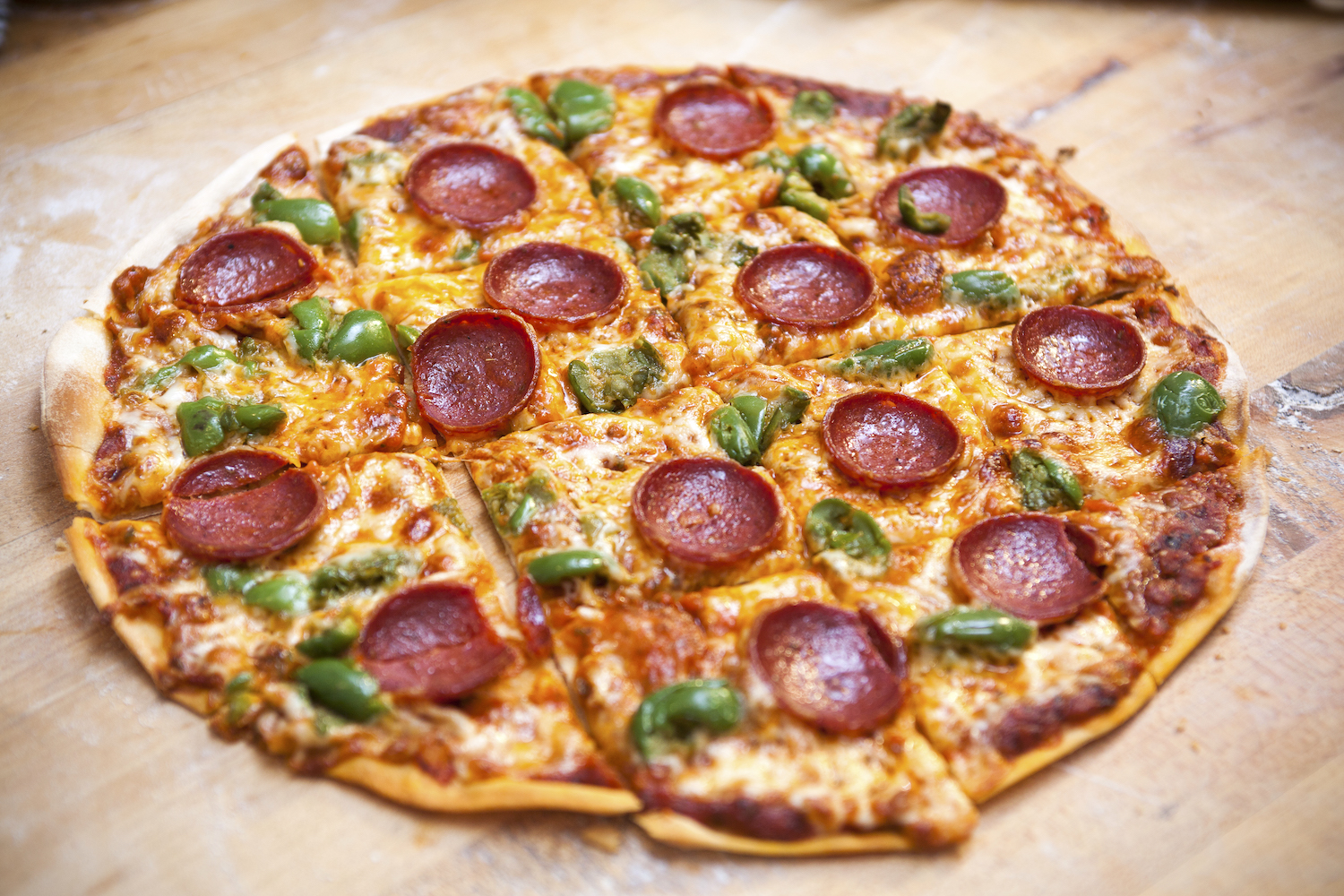I obsess over Chicago-style pizza. No, I’m not talking about two-inch high deep-dish (which has its place in this world). Rather, I’m referring to the pizza most Chicagoans eat on a day-to-day basis — tavern-style pizza. Every neighborhood has a place (or two or three) that serves it. In fact, I loved my local pizzeria so much, we had our wedding rehearsal dinner in the back room. This is part of the charm of the tavern-style pizza, a pie deeply rooted in the history of Chicago.
A tavern-style pizza can of course vary, but some elements are consistent. First, the crust is very thin, no more than 1/3″, with toppings pushed out to the very edge. To get the dough this thin, most pizzerias use a sheeter (a mechanical rolling device akin to a large pasta roller) instead of hand-forming like most styles. The sauce is generally on the sweeter side when compared to others, like a classic New York slice. Finally, a tavern-style pizza will be “party cut,” aka cut into squares, creating both extra cheesy middle slices and the sought-after crunchy corner pieces.
Unsurprisingly, the exact origin of the tavern pie is murky. While many historians have their take, based on my research, I imagine the timeline looks a bit like this: pizza finds its way from New York to Chicago via the World Fair in 1933-1934, the same fair that invented brownies and Cracker Jack candy. While Neapolitan pizza may not have been fully new to Chicago at this time, there’s reason to believe Sicilian pizzas were introduced then. Also in 1933, Prohibition had just ended. Wise bar owners knew they needed to draw in patrons, though most didn’t have full kitchens nor trained pizza chefs in the back of the house. Thus, a pizza that didn’t need hand-rolling, could be cooked in a small oven and cut into squares the same shape as a cocktail napkin was created.
Fast forward to 1946, and Chicago is becoming a pizza town. The deep dish was invented a few years prior, and Chicagoans are developing a taste for pizza to supplement the Italian beef and sausages they love. This is when Vito and Nick’s, a south-side pizzeria often credited for the rise of tavern-style pizza, served their first pie. The rest is delicious history.
The concept traveled across the Midwest in the 1950’s and on. In Wisconsin, tavern-style pies are a mainstay and similar to the Chicago offerings. West in the Quad Cities area (a cluster of towns on the Iowa/Illinois border), a Quad Cities-style pizza will feature the same thin crust, though it’s spiked with molasses and cayenne pepper and cut into strips, not squares. Finally, south in St. Louis, their pizza is even thinner and topped with Provel, a processed white cheese that locals love.
This Digital Club Just Might Make You a Pizza Expert
What started as a way to connect with others during the pandemic has morphed into a global sensationIn case you don’t live in the Midwest (or just love making pizza), tavern-style pizza isn’t too difficult to make at home. The recipe below is unique because the dough calls for beer and water. The beer, along with adding flavor, will inhibit the yeast from rising to create the thin crust. For a crisper crust, roll out the pizza dough, cover and let it “cure” in the fridge overnight. This will dry out the dough, allowing for a better texture in the end.
Chicago Tavern-Style Pizza
Servings: 2-3
Ingredients
- 1.5 cups AP flour
- 1/3 cup warm water
- 1 Tbsp. beer
- .5 tsp. sugar
- 1/3 tsp. salt
- 2 Tbsp. olive oil, divided
- 1 tsp. rapid rise yeast
- .5 cup crushed tomatoes
- 1 Tbsp. tomato paste
- 1 tsp. Italian seasoning
- 3 oz. pepperoni
- 1 cup mozzarella cheese
- 1 Tbsp. grated Parmigiano
Directions
-
-
In the bowl of a stand mixer, combine (in this order) water, beer, sugar, yeast, salt, 1 Tbsp. olive oil and flour. Allow it to mix for 5 minutes at medium-low speed. Transfer the dough to a generously oiled large bowl and let it rise on the counter for 2 hours, giving it a punch-down halfway through.
-
Meanwhile, in a small saucepan, combine 1 Tbsp. olive oil, tomato paste, crushed tomatoes, a pinch of salt and Italian seasoning. Bring to a gentle simmer while whisking in the tomato paste. Cook for 5 minutes, then set aside.
-
Once the dough has risen, preheat the oven to 450 degrees. Using a rolling pin, roll dough into a 12-14” circle, employing bench flour to prevent sticking.
-
Move the dough onto a pizza pan, and top with the sauce, pepperoni, mozzarella and a generous sprinkle of Parmigiano, in that order. Ensure the sauce and cheese reach the edge of the crust. Bake for 15 minutes or until deeply browned on all sides. Cut into squares and serve.
-
Join America's Fastest Growing Spirits Newsletter THE SPILL. Unlock all the reviews, recipes and revelry — and get 15% off award-winning La Tierra de Acre Mezcal.
